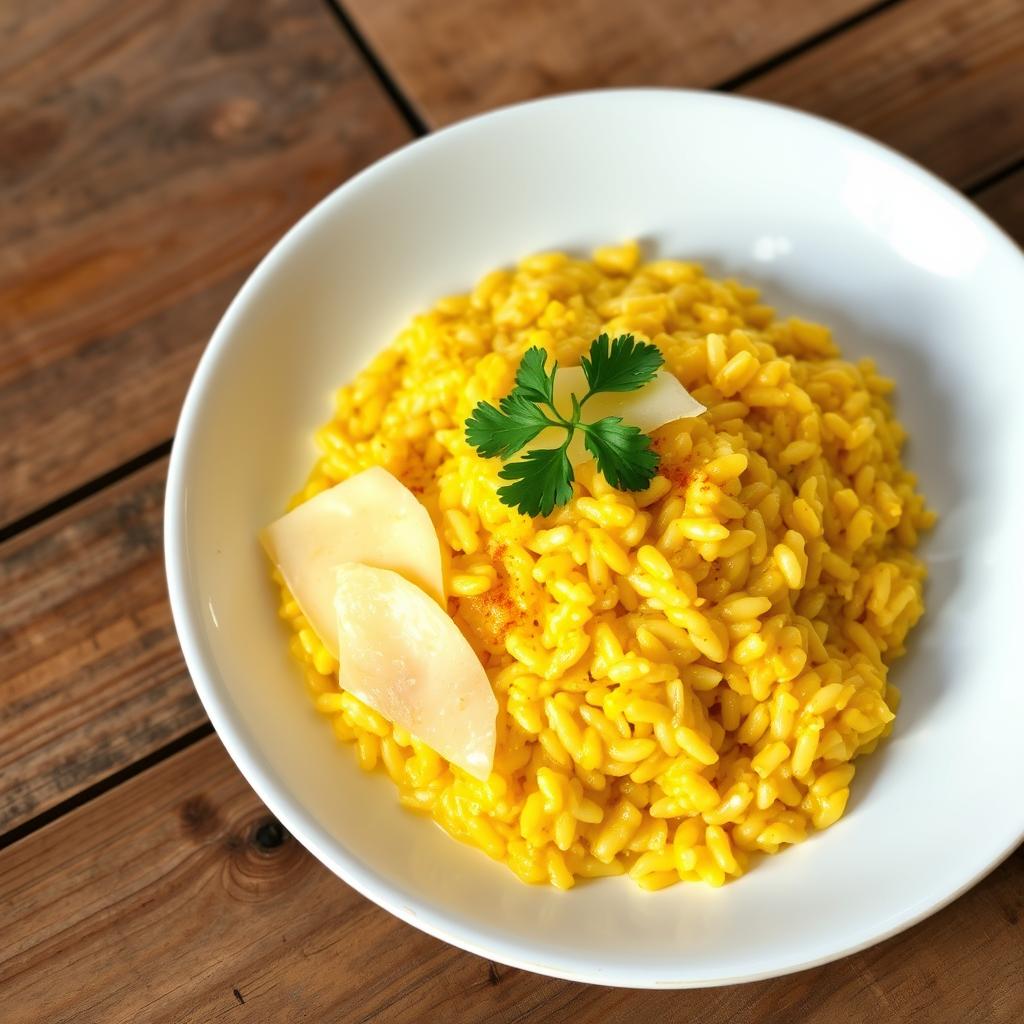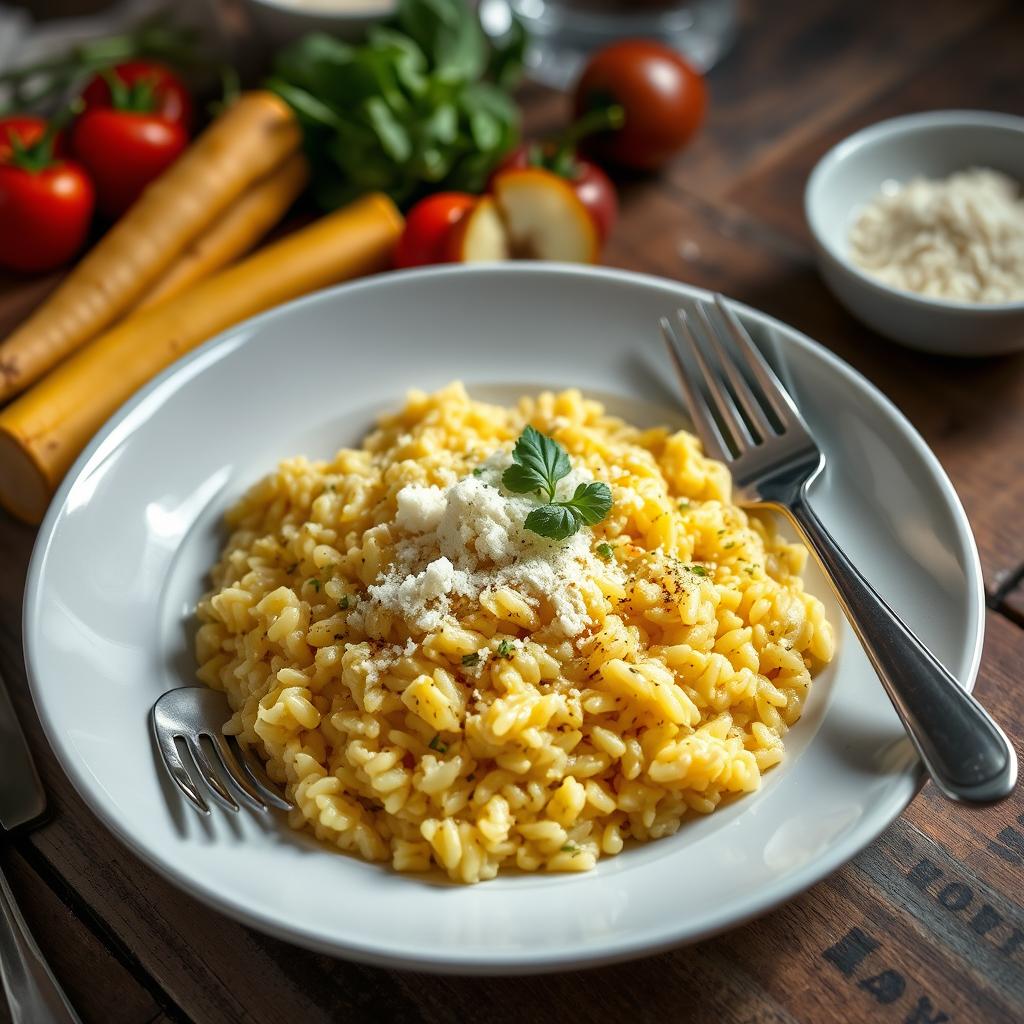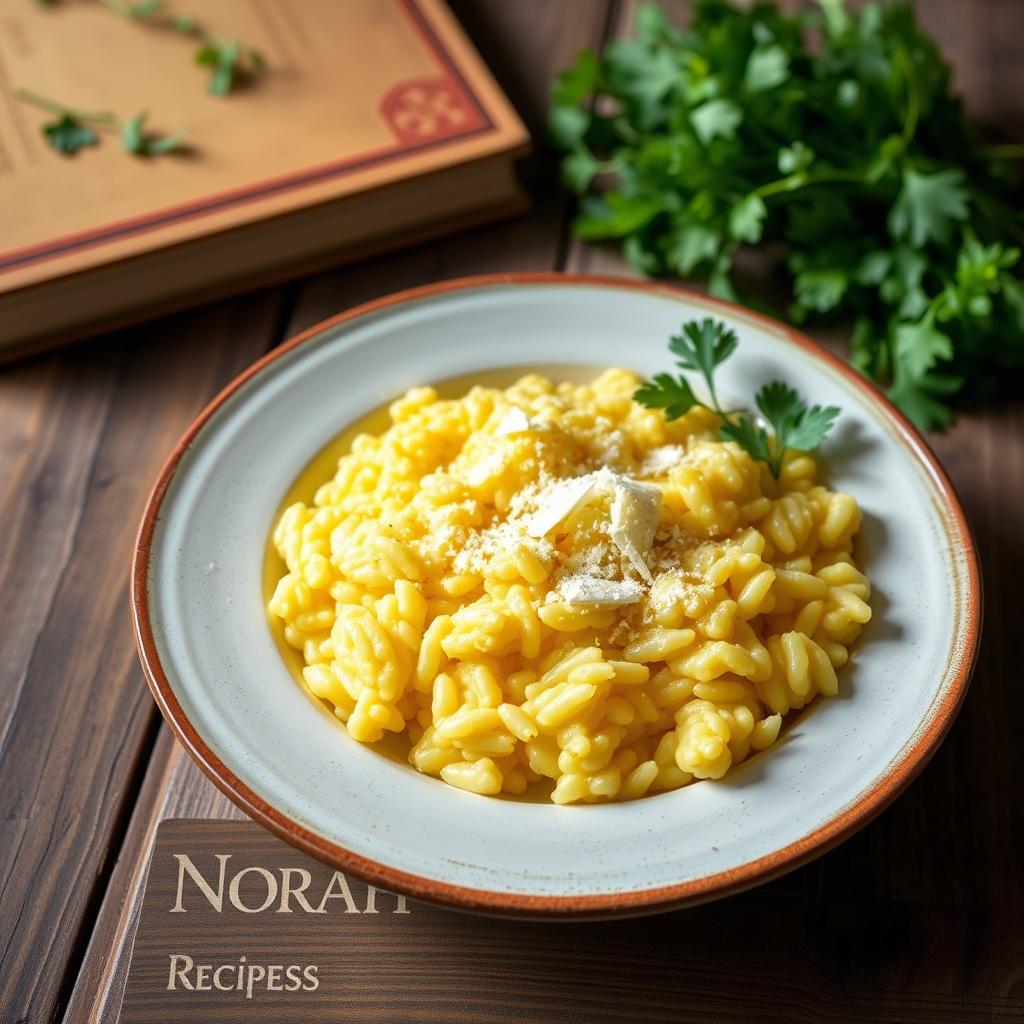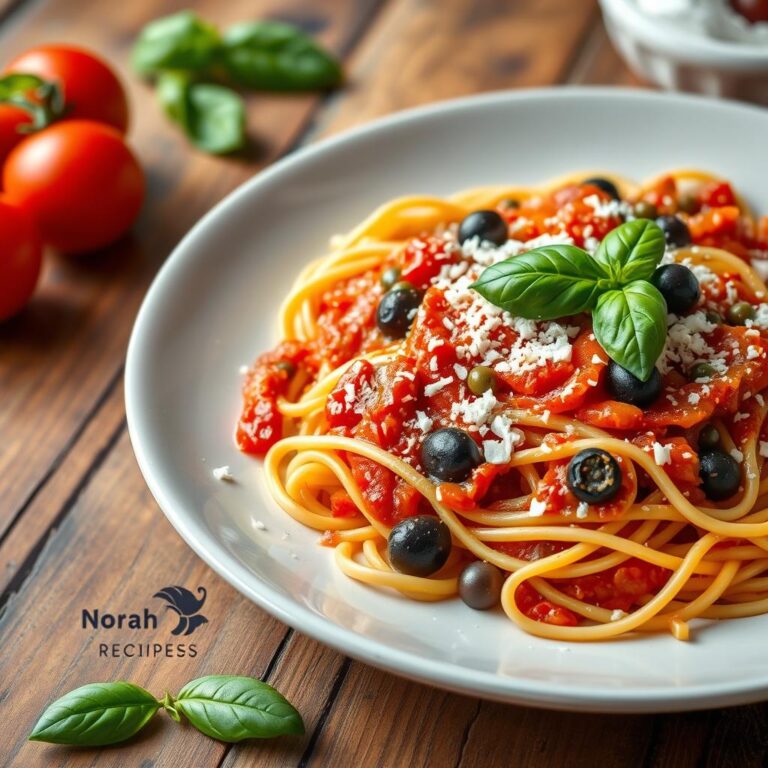Indulge in the Luxurious Creamy Goodness of Risotto alla Milanese – Ready in 30 Minutes
Risotto alla Milanese, also known as Milanese risotto, is a classic Italian dish that originated in the Lombardy region of Milan, Italy. It is known for its creamy texture and distinctive yellow color, which is achieved by using saffron threads. This saffron risotto is a true delight for the senses, with its rich, creamy texture and vibrant yellow color.
Risotto alla Milanese is a beloved classic in Italian cuisine, and its significance extends beyond its delicious taste. With its unique characteristics and high-quality ingredients, such as Arborio rice and Parmigiano Reggiano, this dish is sure to impress. Whether you’re a seasoned foodie or just looking to try something new, Milanese risotto is a great choice.
Key Takeaways
- Risotto alla Milanese is a classic Italian dish with a creamy texture and distinctive yellow color.
- Saffron risotto is a key ingredient in this dish, providing its unique color and flavor.
- Arborio rice is recommended for making risotto due to its high starch content.
- Parmigiano Reggiano is a crucial ingredient for authentic risotto alla Milanese.
- This dish serves 4 to 6 servings and has a total cooking time of 30 minutes.
- Risotto alla Milanese has a rich history and cultural significance in Italian cuisine.
- Extra virgin olive oil and white wine are also important ingredients in this recipe.
The Rich History of Milan’s Golden Rice Dish
Italian risotto has a long and storied history, with its origins dating back to medieval Milan. The city’s humid and water-abundant environment made it an ideal place for rice cultivation, which flourished during the Renaissance era. Traditional risotto, in particular, has become a beloved classic, with its creamy texture and rich flavor warming the hearts of many.
The creation of Risotto alla Milanese is linked to a legend dating back to 1574, when a significant amount of saffron was added to a pot of rice, resulting in the dish’s distinctive golden color. This legendary dish has since become a staple of Italian cuisine, with its cultural significance extending beyond the culinary world.
Origins in Medieval Milan
In medieval Milan, rice was introduced by the Moors and Saracens in the 13th century. The Po valley in northern Italy, where Milan is located, is ideal for rice cultivation due to its flat lands and ample water supply. This region continues to produce significant amounts of rice, making it a crucial part of the local culinary tradition.
The Saffron Legend
The legend of saffron rice dates back to 1754, and it is said that the yellow rice recipe became known as Risotto alla Milanese in 1829. The recipe from the 1829 recipe book included bone marrow, saffron, butter, and rice, prepared similarly to the modern-day recipe. This traditional risotto recipe has been passed down through generations, with its rich history and cultural significance making it a beloved dish in Italian cuisine.
| Ingredient | Quantity |
|---|---|
| Arborio rice | 2 cups |
| Saffron threads | 1 tablespoon |
| Unsalted butter | 3 tablespoons |
Cultural Significance in Italian Cuisine
Risotto alla Milanese is a significant part of the culinary tradition in northern Italy, with its cultural significance extending beyond the culinary world. The dish is often prepared in heavy-bottomed pans, incorporating white wine, saffron, and parmesan cheese. This traditional Italian risotto has become a globally popular dish, with chefs adapting it to incorporate a wide range of ingredients while maintaining the creamy essence of the traditional dish.
Essential Ingredients for Authentic Risotto alla Milanese
To create a delicious and authentic Risotto alla Milanese, it’s crucial to use high-quality ingredients. The dish typically serves 4-6 people and requires essential ingredients such as Arborio rice, saffron, white wine, and Parmesan cheese. Saffron, being the most expensive spice on earth, is worth the investment as a little goes a long way in adding flavor and color to the dish.
Some of the key ingredients for the best risotto recipe include:
- 1 1/2 cups of Carnaroli or Arborio rice
- 6 cups of low-sodium chicken or beef broth
- Grana Padano or Parmesan cheese
- 3 tablespoons of extra-virgin olive oil
- 1 tablespoon of cold unsalted butter
- A pinch or two of saffron threads steeped in hot broth
These ingredients will help you create a creamy risotto that is sure to impress. With the right ingredients and a bit of practice, you’ll be well on your way to making an authentic Risotto alla Milanese that is rich, flavorful, and full of creamy goodness.
Choosing the Perfect Rice for Your Risotto
When it comes to making a delicious risotto Milan style, the type of rice you use is crucial. To achieve the perfect creamy consistency, you need to select a rice that can absorb liquid well and retain its shape. For risotto alla Milanese, the most commonly used rice types are Arborio and Carnaroli. Arborio rice is a popular choice due to its high starch content, which allows it to absorb water up to five times its weight, resulting in a creamy consistency.
Another option is Carnaroli rice, which has a higher amount of starch than Arborio, making it suitable for absorbing flavors while keeping its shape. Both types of rice are well-suited for making risotto alla Milanese, but the choice ultimately depends on personal preference. If you’re looking for a more affordable and easier-to-find option, Arborio rice might be the way to go. However, if you want a more premium and flavorful risotto, Carnaroli rice is worth considering.
Characteristics of Arborio and Carnaroli Rice
- Arborio rice: high starch content, absorbs water up to five times its weight, creamy consistency
- Carnaroli rice: higher starch content than Arborio, absorbs flavors well, retains shape
Learning how to make risotto alla Milanese requires understanding the characteristics of the rice you’re using. By choosing the right type of rice and following the proper cooking techniques, you’ll be able to create a delicious and authentic risotto Milan style that’s sure to impress.
| Rice Type | Starch Content | Absorption Capacity |
|---|---|---|
| Arborio | High | Up to 5 times its weight |
| Carnaroli | Higher than Arborio | Excellent flavor absorption |
The Art of Making Risotto alla Milanese
To create an authentic Milanese risotto, it’s essential to understand the importance of using high-quality ingredients and mastering the right cooking techniques. With a total cooking time of approximately 2 hours, this dish requires patience and attention to detail. The process begins with preparing the ingredients, including chopping a small onion and using butter and oil for frying.
A key aspect of making risotto alla Milanese is the gradual addition of stock, typically done one ladleful at a time. This technique helps to achieve the perfect creamy texture, which is further enhanced by the mantecato step – vigorously stirring cold butter and parmesan into the risotto. Some variations of this dish include adding sautéed baby artichokes, zucchini, peas, or dried porcini to give it a unique twist.

When it comes to pairing risotto alla Milanese with wine, a nebbiolo d’alba is a popular choice. For a classic course, consider following the risotto with Costeletta alla milanese, a veal cutlet breaded and fried in clarified butter, presented with the rib bone protruding jauntily. By mastering the art of making risotto alla Milanese, you’ll be able to create a delicious and authentic dish that’s sure to impress.
Some key tips to keep in mind when making risotto alla Milanese include:
- Using rice from Lombardy’s nearby rice growing fields for the best flavor and texture
- Preparing a saffron bath for the risotto, preferably using saffron from Iran or Greece
- Utilizing vegetable broth instead of poultry or meat broth for a lighter flavor
Mastering the Crucial Techniques
To create an authentic Italian risotto, it’s essential to master the crucial techniques involved in making this traditional dish. One of the key techniques is toasting the rice, which helps to bring out the natural flavors and textures of the rice. This process is critical in making a traditional risotto, as it sets the foundation for the rest of the cooking process.
When making a traditional risotto, it’s also important to use the right type of rice, such as Arborio or Carnaroli, which are specifically designed to hold their shape and create a creamy texture. The ratio of liquid to rice is also crucial, with a common ratio being 7 cups of liquid to 2 cups of rice. This helps to achieve the perfect consistency and texture in the final dish.
The Importance of Toasting Rice
Toasting the rice is a simple yet crucial step in making a traditional Italian risotto. This process helps to bring out the natural flavors and textures of the rice, and it’s essential to get it just right. By toasting the rice, you can create a rich and creamy texture that’s characteristic of a traditional risotto.
Proper Stirring Methods
Proper stirring methods are also essential when making a traditional Italian risotto. This involves stirring the rice constantly, especially when adding the liquid, to prevent the rice from becoming sticky or clumpy. By stirring the rice in the right way, you can create a smooth and creamy texture that’s perfect for serving.
With these crucial techniques mastered, you can create a delicious and authentic Italian risotto that’s sure to impress. Whether you’re making a traditional risotto or trying out a new recipe, the key is to practice and patience, and to always use the freshest and highest-quality ingredients. By following these tips and techniques, you can create a traditional risotto that’s rich, creamy, and full of flavor, just like a traditional Italian risotto.
Saffron: The Golden Secret
To create an authentic saffron risotto, it’s essential to understand the role of saffron in this traditional Italian dish. Saffron threads or powder add a unique flavor and color to the risotto, making it a creamy risotto that’s both delicious and visually appealing.
When preparing saffron risotto, it’s crucial to use high-quality ingredients, including saffron, arborio rice, and vegetable broth. A pinch of saffron threads or ¼ teaspoon of saffron powder is sufficient to give the risotto its distinctive flavor and color. The recipe serves 4 people and has a total preparation time of 30 minutes.
Here are some key tips for making a perfect creamy risotto:
- Use 1½ cups of arborio rice and 6 cups of vegetable broth.
- Add 2-3 tablespoons of extra virgin olive oil and 2 oz of finely grated parmesan cheese.
- Heat the vegetable broth before cooking and add grated parmesan cheese at the end.
- Avoid overcooking the risotto to maintain its creamy texture.

By following these tips and using high-quality ingredients, you’ll be able to create a delicious and authentic saffron risotto that’s sure to impress. This creamy risotto is perfect for special occasions or everyday meals, and its unique flavor and color make it a standout dish in any setting.
| Ingredient | Quantity |
|---|---|
| Arborio rice | 1½ cups |
| Vegetable broth | 6 cups |
| Extra virgin olive oil | 2-3 tablespoons |
| Parmesan cheese | 2 oz |
Common Mistakes to Avoid When Making Risotto
When it comes to making the best risotto recipe, it’s essential to avoid common mistakes that can ruin the dish. Risotto Milan style is known for its creamy texture and rich flavor, but achieving this can be tricky. One of the most critical factors is temperature control, as it can affect the cooking time and texture of the rice.
To make a perfect risotto, it’s crucial to maintain a consistent temperature and avoid overheating the stock. This can cause the rice to become mushy and unappetizing. Another mistake to avoid is adding too much stock at once, which can lead to a soggy and unappealing texture. Instead, add the stock gradually, stirring constantly to achieve the perfect consistency.
- Not using the right type of rice, such as Arborio or Carnaroli
- Not toasting the rice before adding the stock
- Not stirring the risotto constantly, which can cause it to stick to the bottom of the pan
- Not adding the stock gradually, which can lead to a soggy texture
- Not serving the risotto immediately, as it can become cold and unappetizing
By avoiding these common mistakes, you can create a delicious and authentic risotto Milan style that’s sure to impress. With practice and patience, you can master the art of making the best risotto recipe and enjoy this classic Italian dish in the comfort of your own home.
| Mistake | Consequence | Solution |
|---|---|---|
| Overheating the stock | Mushy rice | Maintain a consistent temperature |
| Adding too much stock | Soggy texture | Add stock gradually, stirring constantly |
| Not stirring the risotto | Rice sticks to the bottom of the pan | Stir the risotto constantly |
Traditional and Modern Serving Suggestions
When it comes to serving risotto alla Milanese, there are many traditional and modern options to consider. This classic Italian dish is often paired with osso buco, grilled or roasted meats, Italian roasted vegetables, or a simple side salad. For a more modern twist, you could try pairing it with scallops or shrimp, or even a green salad with a light vinaigrette.
A dry white wine, such as Pinot Grigio, is the perfect accompaniment to risotto alla Milanese. The crisp, dry flavor of the wine complements the rich and creamy texture of the dish, creating a truly unforgettable dining experience. If you prefer red wine, a light-bodied option like Barbera d’Asti is also a great choice.

Some other traditional serving suggestions for Milanese risotto include pairing it with cotoletta alla milanese, a classic dish from Milan that consists of pounded veal cutlets that are breaded and fried. You could also try pairing it with cassoeula, a traditional winter stew made with pork parts, sausage, onions, carrots, celery, and cabbage.
For a more modern take on the traditional dish, you could try adding some green peas or asparagus tips to the risotto alla Milanese. This will not only add some extra flavor and texture to the dish, but it will also create a beautiful and colorful presentation. Whatever serving suggestion you choose, be sure to pair it with a glass of wine and enjoy the rich and creamy goodness of risotto alla Milanese.
Regional Variations and Modern Interpretations
Italian risotto, particularly the traditional risotto, has undergone numerous regional variations and modern interpretations. From the classic Risotto alla Milanese to innovative fusion recipes, the dish has evolved to incorporate unique ingredients and flavors.
Some notable regional variations of Risotto alla Milanese include Risotto al Barolo from Piedmont and Risotto alla Pilota from Mantova. These variations showcase the diversity of Italian cuisine and the importance of regional ingredients and techniques.
A list of popular regional variations of Risotto alla Milanese includes:
- Risotto al Barolo from Piedmont
- Risotto alla Pilota from Mantova
- Risotto al Nero di Seppia along the Adriatic coast
Modern interpretations of traditional risotto have also become popular, with chefs experimenting with new ingredients and techniques. These innovative recipes have helped to introduce Italian risotto to a wider audience and showcase its versatility.
A table highlighting some modern interpretations of traditional risotto is as follows:
| Recipe | Ingredients | Region |
|---|---|---|
| Pumpkin Risotto | Pumpkin, sage, Parmesan | Northern Italy |
| Black Rice Risotto with Dashi | Black rice, dashi, seafood | Adriatic coast |
| Strawberry Risotto | Strawberries, balsamic vinegar, cream | Central Italy |
These regional variations and modern interpretations of Italian risotto demonstrate the dish’s ability to evolve and adapt to different tastes and ingredients, while remaining true to its traditional roots.
Conclusion: Mastering the Art of Perfect Risotto alla Milanese
As we conclude our journey through the rich history and preparation of Risotto alla Milanese, it’s clear that mastering this iconic dish requires patience, practice, and a deep appreciation for the key ingredients and techniques involved. From the selection of the perfect Arborio or Carnaroli rice to the precise timing of the saffron addition, every step plays a crucial role in achieving the creamy, flavorful perfection that defines this Milanese risotto.
Consistency is key when it comes to saffron risotto, and with a little dedication, home cooks can learn to navigate the nuances of risotto preparation. By understanding the importance of proper temperature control, gradual stock addition, and meticulous stirring, you’ll be well on your way to crafting a Risotto alla Milanese that will impress your guests and transport them to the vibrant culinary scene of Milan. So embrace the art of risotto-making, experiment with seasonal variations, and savor the golden, creamy goodness of this timeless Italian delicacy.
FAQ
What is Risotto alla Milanese?
Risotto alla Milanese is a beloved classic dish in Italian cuisine, originating from the city of Milan. It is a creamy and flavorful rice dish made with Arborio or Carnaroli rice, infused with the vibrant yellow color and unique taste of saffron.
What is the history and cultural significance of Risotto alla Milanese?
Risotto alla Milanese has deep roots in medieval Milan, with saffron playing a crucial role in its development. The dish has become a symbol of traditional Italian cooking and holds a special place in the culinary heritage of the country.
What are the essential ingredients for making authentic Risotto alla Milanese?
To create an authentic Risotto alla Milanese, you’ll need high-quality ingredients such as Arborio or Carnaroli rice, saffron, onions, broth, butter, and Parmesan cheese.
How do I choose the right type of rice for Risotto alla Milanese?
The key to a perfect Risotto alla Milanese is using the right type of rice, such as Arborio or Carnaroli. These varieties have a high starch content, which helps to create the creamy texture that is essential for this dish.
What are the essential techniques for making Risotto alla Milanese?
Mastering the art of Risotto alla Milanese involves techniques like toasting the rice, adding the broth gradually, and stirring the dish constantly to achieve the perfect creamy texture.
What is the role of saffron in Risotto alla Milanese?
Saffron is the key ingredient that gives Risotto alla Milanese its distinct golden color and unique flavor. Properly infusing the saffron into the dish is crucial for achieving the authentic taste and appearance of this classic Italian dish.
What are some common mistakes to avoid when making Risotto alla Milanese?
Some common mistakes to avoid include issues with temperature control, stock addition, and timing. Paying close attention to these details is essential for creating a delicious and authentic Risotto alla Milanese.
How should Risotto alla Milanese be served and paired?
Risotto alla Milanese is traditionally served hot, often accompanied by classic pairings such as sautéed meat or fish. The dish also pairs beautifully with a variety of Italian wines, helping to balance the creamy texture and bold flavors.
What are some regional variations and modern interpretations of Risotto alla Milanese?
While Risotto alla Milanese is a classic Italian dish, there are various regional variations and modern interpretations that put unique spins on the traditional recipe, often incorporating local ingredients and techniques.
For more delicious pasta recipes, be sure to check out these posts:
- Vermicelli Puttanesca – A bold and flavorful dish with olives, capers, and tomatoes.
- Orecchiette with Sausage – A hearty pasta dish that combines savory sausage with tender orecchiette.
- Elote Pasta Salad – A creamy, zesty fusion inspired by Mexican street corn.
For more cooking inspiration, visit the full recipe collection on NorahsRecipes.com.

Indulge in the Luxurious Creamy Goodness of Risotto alla Milanese – Ready in 30 Minutes
Ingredients
Method
- Heat olive oil and half the butter in a large pan over medium heat. Add onion and sauté until soft.
- Stir in rice and cook for 1-2 minutes until slightly translucent.
- Add white wine and cook until mostly evaporated.
- Gradually add warm broth, one ladle at a time, stirring continuously until absorbed before adding more. Repeat until the rice is creamy and tender (about 20 minutes).
- Stir in saffron with its water, Parmesan cheese, and the remaining butter. Season with salt and pepper.
- Let rest for 5 minutes before serving.






